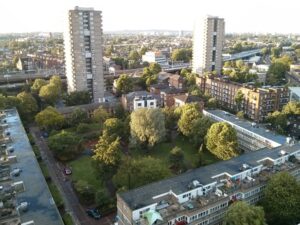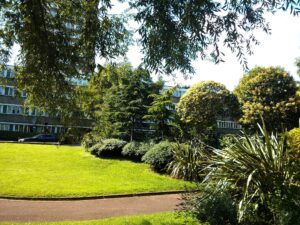 Silchester East and West form a housing estate in Notting Dale at the edge of Notting Hill, in the north of the Royal Borough of Kensington and Chelsea.
Silchester East and West form a housing estate in Notting Dale at the edge of Notting Hill, in the north of the Royal Borough of Kensington and Chelsea.
It is home to a well-established, diverse and multi-cultural community, many of whom have been here for decades.
The estate was planned by the LCC in the mid 1960’s and built by the then Greater London Council during a radical campaign to clear the slums which had grown from the 1930’s.
With the building of the Westway and Western Cross Route, many of the existing buildings were removed from the area and this created the spaces around which the estates were built.
Silchester estate, incorporates four residential towers and clusters of low-rise buildings set around communal/ public gardens.
Each tower has a garden at the base. One of the smaller gardens at the base of Whitstable house has been transformed into an allotment for residents.
Waynflete Square, at the heart of the Estate is a square of low rise apartments, built around a well maintained landscaped garden with mature trees, flower beds and a playground. But Waynflete Square is a relatively new addition to the estate. Until the early 1980s, this was a gloomy, grey expanse of elevated concrete terrace, forming the roof over some lower ground garages which had become derelict and disused.
These garages were demolished around 1982/3 and Waynflete garden square was born. This changed everything. With the new open, green space, trees and flowers, the whole atmosphere of the area improved dramatically. And now, some 40 years later, we have the most beautiful green space with a diverse array of trees and shrubs, full of life and joy, an epitome of biodiversity, a kind of micro eco system, which is not only good for the inhabitants but also for the environment.
In 1985 a new row of town houses was added to the northern side of Waynflete Square, to the south of Dixon house tower – designed by Miller McCoy, it created Charlotte mews which is managed by a housing association. Although this meant that Dixon house lost their garden, they still have small strips of green plantation around the base of the tower.
We adore our open spaces and delighted that we have such biodiversity at our doorstep. We particularly enjoy the song birds, bees and butterflies in our garden square – something which is rather rare and especially precious in the middle of a crowded and noisy urban area, with the motorway above, the railways across and busy main roads all around.
Since the 1979 legislation, many of our residents have exercised their right to buy and are now leaseholders of their homes which demonstrates the shining success of our community and implies growing prosperity in the estate.
The right to buy is of course a good thing, It is, however, a pity that so much of the social housing stock all over the country has been sold and not enough built to replace them, which has led to a shortage of social housing.
In North Kensington, unfortunately, it is extremely difficult to build enough dwellings to meet the demand, due to shortage of land, which is a historic issue and dates back to the early 19th century.
However, within our estate, from tenants, and leaseholders, toddlers, teenagers and thirty somethings, to young families and young at heart pensioners, we have been living here happily and in perfect harmony for many years, enjoying our gardens, playgrounds, community events and allotments. That’s why we called our Facebook page We Love The Silchester Estate.